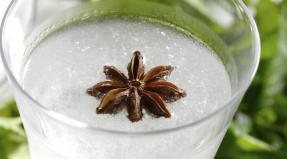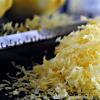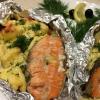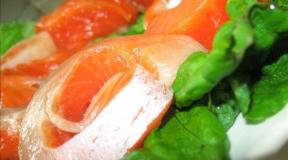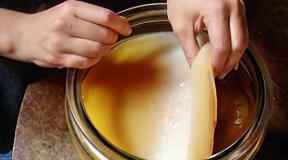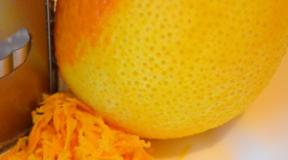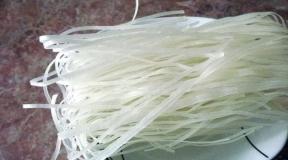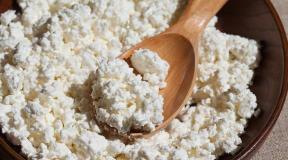Food additives E: why use and production. Food additives (preservatives) in products
It's no secret that many food additives are very dangerous. In a lifetime, a person eats about 40 tons of food. More than 25% of this is chemicals and life-threatening substances. Flavorings, dyes, thickeners, flavor enhancers, GMO products, preservatives. We consume chemicals every day, and often without even thinking about it. Food additives make food tastier, more beautiful, but not healthy and healthy, but dangerous to health and sometimes life.
Sunset Yellow E110
Dye Sunset Yellow FCF, also known as Yellow-Orange S, labeled E-110, is a bright orange color that dissolves easily in water.
Dye E110 is added to a huge amount of food. It contains some canned vegetables, dairy products, sauces, croutons, chips, instant soups and purees, canned fish. Alcoholic and non-alcoholic drinks may also contain this additive. Yellow "sunset" E110 can often be found in sweets. Ice cream, jams, jellies, icing, marmalade, marzipans, hot chocolate - all these sweets may contain E110 dye. It is mainly used to give yellow, orange, caramel and chocolate color.
Impact on the human body
The dye E110 can lead to allergic reactions, especially in people with aspirin intolerance. This allergy can manifest as nausea, hives (rash), nasal congestion, rhinitis (runny nose). In addition, there is indirect evidence that E-110 can provoke hyperactivity and attention deficit in children.
For humans, it is no more dangerous than any other food allergen and carcinogen, for example, citrus fruits or fried meat. However, since it does not carry any useful properties, a number of human rights groups are in favor of banning E110 in order to avoid the potential risks associated with it.
Banned in Norway, Finland and Russia, but allowed in the rest of the European Union and the United States.
Sodium sorbate (E201)
Sodium sorbate is one of the common preservatives - substances that increase the shelf life of food products, protecting them from spoilage by the waste products of bacteria, viruses and fungi.
Sodium sorbate is widely used in the preparation of fruits and vegetables, juices and drinks.
It can be found in candied fruits, cheeses, cider, sweet sauces, dried fruits, fillings, fermented milk, frozen convenience foods, meat and fish products, fruit salads, margarine, processed cheeses, soft drinks, soup concentrates, sweets, yoghurts.
As a negative effect on the human body, it is indicated that sodium sorbate sometimes provokes allergic reactions, such as reddening of the skin or itching, but when consumed in recommended doses, it is well tolerated by the body.
Ascorbic acid (E300)
Ascorbic acid is an antioxidant that is a natural antioxidant. It has properties to bind free radicals, thereby stopping their destructive function. Vitamin C is able to enhance the active action of other antioxidants.
Ascorbic acid is used to preserve the natural color of meat products and protects products from oxidative phenomena and processes. Being a natural substance, ascorbic acid is naturally found in many plant products such as: citrus fruits, potatoes, white cabbage, peppers, black currants and others. There is especially a lot of vitamin C in fresh herbs and, which is especially important during periods of exacerbation of diseases, in sauerkraut and onions.
Effect on the human body:
The properties of E-300 are diverse and have a very beneficial effect on the human body. Vitamin C stabilizes the function of blood clotting, regulates the amount of lipids, participates in the formation of connective and bone tissues. Ascorbic acid improves the functioning of the human immune system and provides protection for the body against various infections, as well as numerous allergens.
Orthophosphoric acid E338
Orthophosphoric acid E338 refers to inorganic acids, is an antioxidant.
Orthophosphoric acid E338 is used in various fields of human activity. In industry, it is involved in soldering as a flux for ferrous metals, stainless steel, oxidized copper. In molecular biology, an additive is necessary for a number of studies. It shows its qualities very well in the process of cleaning metal parts and surfaces from rust and prevents subsequent corrosion by covering it with a protective film.
In the food industry, phosphoric acid E338 is used as an acidity regulator, mainly in sweet sodas. E338 is also added to sausage products, in the production of cheeses and processed cheeses, in baking powders intended for bakeries. Orthophosphoric acid is also used in sugar making.
It plays an important role in the agricultural sector in the production of fertilizers for the soil, the production of phosphates for livestock feed. There is also an additive in detergents, cleaning and softening synthetic products.
Effect on the human body:
Orthophosphoric acid E-338 increases the acidity of the body, which negatively affects its acid-base balance. In this case, the forced displacement of calcium from the teeth and bones occurs, which leads to the appearance of caries and the development of early osteoporosis. In addition, it is contraindicated for people with a natural high level of acidity. Additive E338 is not safe. A concentrated solution, once on the skin or mucous membranes, leads to burns. When inhaled vapors of phosphoric acid develop atrophic processes in the nasopharynx, bleeding from the nose may occur, tooth enamel and the tooth itself crumble, even a change in the composition of the blood is observed. With frequent and abundant use of E338 in food, disturbances occur in the gastrointestinal tract, vomiting, diarrhea, nausea, aversion to food, and weight loss appear.
Ethylcellulose (E462)
Ethylcellulose is a stabilizing agent used to maintain the viscosity and consistency of food products. The additive can be used as a thickener capable of significantly increasing the viscosity of products. E-462 has the properties of preserving the structure of food products, and contribute to obtaining products with the required consistency. Ethylcellulose is especially widely used to stabilize disperse systems: suspensions, foams and emulsions.
Ethylcellulose in the food industry can be part of:
- - instant soups and ready-made sauces,
- - canned soups and sauces,
- - deep-frozen products,
- - fruit fillers and other fruit processing products,
- - fruit and vegetable preserves,
- - fermented milk mixtures and dry milk products,
- - desserts, jelly, mayonnaise,
- - processed cheeses and cheese products,
- - confectionery and sugar products,
- - ketchups and various low-calorie food products.
Effect on the human body:
Ethylcellulose is one of the additives not allowed on the territory of the Russian Federation, therefore, excessive consumption of products with this additive can lead to the development of severe inflammation of the mucous membranes of the body and especially the organs of the digestive system. In children, there may be a state of nervousness. Additive E462 can cause acute indigestion. Being a conditionally dangerous substance, ethylcellulose can have a negative effect on the skin. Additive E-462 is not an allergen, but, however, when working with it, certain safety measures should be observed.
Potassium carbonate (E501)
The use of potassium carbonate in the modern food industry is limited. Now the additive E501 is used as an acidity regulator and stabilizer of soft drinks, and potassium carbonate also appears in the composition (impurity) of baking soda.
Effect on the human body:
Additive E501 is dangerous in suspension. Getting into the respiratory tract of a person during breathing, it can cause severe irritation, an allergic reaction, and provoke an asthmatic attack in chronic patients. When in contact with the skin in its pure form, it can also lead to local irritation and eczema. In this case, it is desirable to wash off the powder as soon as possible with running water. It has a number of contraindications for use in baby food.
Monosodium glutamate (E621)
Monosodium glutamate supplement has the form of a crystalline white powder or pure white crystals. E621 is odorless and has a specific and characteristic taste. It is completely soluble in an aqueous medium, has an average level of solubility in ethanol and is completely insoluble in ether. Monosodium glutamate is obtained by microbiological synthesis. E621 can be of natural and synthetic origin. The additive has the ability to increase the sensitivity of the receptors of the tongue, and, as a result, enhance the taste sensations. As a result, it is used mainly as a food additive - an effective flavor enhancer.
The flavor and aroma enhancer E621 is most often added to canned dishes, concentrates of ready-made first and second courses intended for instant cooking. It is also present in canned fish and meat, pates, chips, sauces, crackers, mayonnaise, ketchups, and other prepared foods with added salt.
Impact on the human body
The human body recognizes the food supplement E621 as a normal nucleic acid, it is absorbed and metabolized. According to the latest data, the E621 additive definitely harms the body. In sensitive individuals or at high doses, monosodium glutamate may cause a specific "Chinese restaurant" syndrome. It manifests itself in general weakness, palpitations, temporary loss of sensation in the back and neck. May cause loss of vision and thinning of the eye retina (the result of experiments on rats). Leads to glaucoma. Hygiene standards allow the maximum allowable daily dose for humans - 120 mg of acid per 1 kilogram of body weight. According to the latest data from foreign sources, studies were conducted that proved that E621 with prolonged use can lead to a number of serious diseases, such as: Alzheimer's disease, autism, attention deficit disorder, diabetes, hyperactivity disorder, migraine, as a result, as it turned out E621 can bring significant harm, especially to children.
Glycine (E640)
In the food industry, glycine is used to optimize the taste and smell of some beverages, mainly alcoholic beverages. In some types of products, the flavor enhancer E640 is added as a carrier of useful substances.
Impact on the human body
In rare cases, glycine can cause an allergic reaction. Additive E640 acts as a regulator of metabolic processes in the body, activates protective inhibition of the central nervous system, reduces mental and emotional stress, and has a beneficial effect on mental performance. It has been noticed that glycine improves mood, facilitates falling asleep, and normalizes the rhythm of sleep. Studies have shown that glycine can reduce the toxic and destructive effects of alcohol on the nervous system.
Tetracyclines (E701)
Dietary supplement E701 is an antibiotic that can disrupt the formation of complexes between the ribosome and RNA, and also leads to the suppression of protein synthesis. Tetracyclines are active against gram-positive and gram-negative microorganisms. Tetracyclines have a fairly wide spectrum of antimicrobial activity, so the substance belongs to antimicrobial drugs. But if you use an antibiotic for a long time, bacteria become resistant to it.
In the food industry, tetracyclines are added to dairy and sour-milk products. As a residual effect of the treatment of livestock, E701 can be found in meat, eggs. The main function of an antibiotic is to suppress germs and infections.
Effect on the human body:
This antibiotic tends to accumulate in the human or animal body, which leads to the fact that in case of illness, treatment with tetracyclines or similar drugs will not work. E701 also accumulates in the bones, regular antibiotic use can lead to the development of allergies, nausea, loss of appetite, diarrhea, vomiting, esophagitis, glossitis, gastritis, dysphagia, hepatotoxic effect, gastric and duodenal ulcers, pancreatitis, intestinal dysbacteriosis.
Avoparcin (E715)
The antibiotic avoparcin is an effective agent that fights gram-positive bacteria, destroying the walls of bacterial cells. The main task of the drug is the prevention and treatment of necrotic enteritis in chickens, ducks, geese, turkeys, guinea fowls. In addition, the E715 additive is used in animal husbandry, as a feed additive for livestock, to accelerate the growth of animals and birds.
The use of food additive E715 was allowed in Australia and some countries of the European Union, but due to the negative impact on human health, avoparcin was excluded from the list of allowed additives. The main scope of the antibiotic is veterinary medicine and industrial animal husbandry.
Effect on the human body:
The danger of avoparcin for health lies in many factors, including the development of allergic reactions, decreased immunity, disorders of the gastrointestinal tract. Also, the addition of E715 can provoke the appearance of bacterial immunity to various antibiotics, which can lead to their resistance and severe clinical conditions of the patient.
Isobutane (E943b)
Isobutane is a colorless, odorless, combustible gas. It is highly soluble in solvents of organic origin, in water, ether and alcohol. In nature, the E943b additive is found in petroleum gases and gas condensate.
In the food industry, isobutane acts as a propellant in inhalation and food packaging, in particular, it is part of the deodorant mixtures in spray cans. Sometimes it is used as a flavoring solvent (technological and extraction). The E943b additive is widely used as a refrigerant in the production of household refrigerators, air conditioners, and freezers. Its distinctive property is that it does not have a negative effect on the ozone layer.
Impact on the human body
In the food industry, the doses of isobutane that enter the final product, ready for consumption, are negligible. This suggests that isobutane in the food industry is safe for human health. The danger is the addition of E943b in high concentrations and at unacceptably high temperatures, which can lead to self-ignition of the substance or its explosion.
Random Fact:
Caffeine stimulates appetite by increasing the secretion of gastric juice. Therefore, regular consumption of caffeinated beverages on an empty stomach can cause stomach problems. —
Article added by user Unknown
05.05.2011
Briefly about nutritional supplements
Food additives are various substances added to foods to improve their taste, color, give them a special texture, and increase shelf life. In recent decades, the chemical industry has been developing by leaps and bounds, and on the products that we buy, we see more and more new names that are not always clear to us: thickeners, sweeteners, dyes, flavors, preservatives, etc. There are disputes about their necessity and harmlessness. Just in case, we all need to know what these labels on the packages mean.
Food additives are divided into several groups, according to the functions they perform.
Nutritional supplements increase the nutritional value of foods. It was with the help of such additives that it became possible to buy products that contain a large amount of various vitamins and microelements, the right amount of fats, carbohydrates, and fiber.
Antioxidants are used to keep food fresh for a long time. They must prevent the interaction of metals and food components, the loss of its color, taste.
Additives that help the products get the right look, color contribute to better whipping of cream into foam, curdling of fermented milk products. This includes chelating agents and sequestrants, as well as texture modifying agents.
Preservatives are well-known additives that allow you to keep the product for a long time without losing its taste and nutritional properties. Even ancient people used sugar, salt, smoke, on which they smoked products, as preservatives. Today, for the storage of vegetables and fruits, I use sodium benzoate, potassium. Vinegar is used as a preservative. Sulfites, sulfur dioxide are used to store dry vegetables and fruits. In the production of flour and dairy products, propionates play a huge role, which prevent molds from multiplying.
Dyes are used everywhere to give products a certain color. Dyes can be natural or synthetic. Recently, along with the fashion for a healthy lifestyle and environmentally friendly products, people prefer dyes with a natural base, which are mainly extracted from various plants.
Texturants are additives to give products a special, improved texture. For example, calcium makes canned tomatoes firmer and more resilient. Phosphates, on the contrary, soften, reduce the density of products. Emulsifiers give a thicker consistency to oily liquids. Baking powders are used in baking, for the appropriate characteristics of bakery products.
Sweeteners have been mined in large quantities since ancient times. The most common, of course, was sugar. However, the desire to reduce the calorie content of foods has led to the fact that they began to withdraw and use artificial sweeteners. Some artificial sweeteners are 200 times sweeter than sucrose, so research is ongoing to find the best options to improve the taste of products.
Many tend to believe that the very combination of "food additive" already carries the meaning of the fact that this is some kind of chemical compound, certainly harmful and dangerous. It should be noted that today there are many substances that meet all sanitary and epidemiological standards and are extracts of natural products: citric, acetic, lactic acid, sucrose. Of course, there are additives that are really unhealthy for our body, for example, nitrites contained in smoked sausage (the norm of the content of substances is higher, because it is believed that they are consumed in smaller quantities). Artificial dyes are often easy to recognize by their characteristic unnatural color and smell.
Food and biological active additives
Nutritional supplements- chemical or natural substances that are not used in their pure form as a food product or a typical food ingredient, which are intended to be introduced into the food product during its processing, processing, production, storage or transportation (regardless of its nutritional value) as an additional component that has a direct or indirect impact on the characteristics of the food product (STB 1100-98). Currently, about 2 thousand food additives are used in the food industry.
Nutritional supplements can be divided into three main groups according to their purpose:
Improving the organoleptic properties of products: food colorings; color-correcting and bleaching agents; flavoring and taste; product consistency improvers;
Inhibiting microbiological and oxidative spoilage of products: preservatives, antioxidants;
Technology-driven: process accelerators - leavening agents, foaming agents, solvents, etc.
The classification of food additives according to the purpose according to the proposed digital codification system is as follows:
E10O-E182- dyes(used to color some food products in different colors);
E200 and beyond - preservatives(contribute to long-term storage of food); IEZOO and beyond - antioxidants, differently, antioxidants(slow down oxidation and thereby protect food from spoilage, similar in action to preservatives);
E900 and beyond - antifoam substances (reduce foam, for example, when pouring juices). Same here , as well as the newly formed E1000 group includes glazing(from "icing") agents; sweeten juices and confectionery; supplements, preventing caking sugar, salt; for processing flour, starch, etc.
The main form of state legislation regulating the use of food additives in the Republic of Belarus is the State Standards, Hygienic Requirements for the Quality and Safety of Food Raw Materials and Food Products and Biomedical Requirements for Sanitary Standards for the Quality of Food Raw Materials and Food Products (Food Additives. Supplement to the MBT ").
The main groups of food additives that have the greatest hygienic significance are characterized below.
Food colorings are divided into three groups:
Natural dyes of plant and animal origin;
Artificial (synthetic), organic dyes;
Mineral dyes (limited use).
natural dyes from a hygienic point of view, they are most preferable for use in the food industry, as they contain biologically active, flavoring and aromatic substances that give finished products not only an attractive appearance, but also a natural aroma and taste. Natural dyes are obtained from vegetable raw materials (carrots, rosehips, beets, pomegranate peels, rose petals, pumpkins, peppers, calendula flowers, etc.).
Carotenoids- a large group of pigments of yellow, orange and red colors. More than 300 carotenoids have been found. For example, an annual capsicum contains up to 100 individual carotenoid pigments: carotene, capsorubin, capsanin, cryptoxanthin, and others. The term "carotenoids" refers to many vegetable yellow and orange pigments that are soluble in fats and fatty media.
Anoxic carotenoids include lycopene and α-, β-, γ-carotenes.
Most common β-carotene, simultaneously being an antioxidant and provitamin A. In the body, decaying, it transforms into this vitamin. Carotene is used to color cow butter, cheese, mayonnaise, margarine, fish products, etc.
β-carotene is widely used in the production of therapeutic and prophylactic products as an antioxidant, to extend the shelf life of the product and increase the nutritional value (kefir, yogurt, curd products, mousses, etc.). It is widely used for coloring and fortifying fruit and vegetable juices, confectionery and bread products, ice cream, etc.
Lycopene- the main pigment of the fruits of red tomatoes. Its source is waste processing of ripe tomatoes.
Yellow dyes include extract annatto, called bioxin, which is obtained from the substance surrounding the seeds of Bixa annatica. Bixin 160V is used for tinting
butter and cheeses.
Flavonoids combine a large group of natural pigments, which are phenolic glycosides: yellow flavones and flavonols, anthocyanins red, purple and blue. Flavonol quercetin and its glycosides are a yellow dye that is found in onion scales, pears, plums, and citrus fruits. The raw materials for obtaining yellow dyes quercetin and rutin (vitamin P) are buckwheat green mass, horse chestnut flowers, and onion scales. Quercetin and rutin have antioxidant properties.
Yellow natural dye - turmeric and turmeric E100 is obtained from plants of the ginger family. Turmeric rhizome powder is called tumeric. It is poorly soluble in water, which is why it is used in the form of an alcohol solution.
Anthocyanins have a wide range of colors. Depending on the reaction of the environment, anthocyanins can change color. So, red-violet anthocyanin isolated from red cabbage at pH 4-5 acquires a pink color, pH 2-3 - red, pH 7 - blue, pH 10-green. To obtain anthocyanin dyes, the juice of blackberries, viburnum, mountain ash and other plants is used. Red dyes E162 are obtained from pomace of cranberries, red beets, blueberries, black currants, raspberries and other raw materials. These dyes are widely used in the production of alcoholic beverages, confectionery and for coloring non-alcoholic!
drinks.
The green color of the dyed product is given by chloryphyll E140 and its derivatives, which are obtained from needles, nettle leaves, and other plant materials. The dye is used for coloring confectionery, alcoholic beverages, soft drinks, etc.
Dye trigonella- blue-green powder is used for tinting and flavoring green cheese and processed cheeses.
Natural dyes are sugar color(E150 caramel) - a dark-colored sugar caramelization product obtained by heating it with ammonia or ammonium sulfate. For tinting alcoholic and alcoholic beverages, the dairy industry uses burnt sugar, obtained without the use of ammonia and salts.
natural red is carmine E120. By chemical nature, it is an anthraquinone derivative. The coloring matter is carmic acid. Source - cochineal - insect (aphid),| living on some types of cacti in Africa and South America.
artificial(synthetic) dyes are less sensitive to processing and storage conditions, and, of course, more stable than natural dyes.
Approved for use in the Republic of Belarus are indocarmine E132, tartrazine E102, ponceau 4R (crimson 4R), sunset yellow E110, quinolenic yellow E104, aerubine E121 charming red E129, patent blue E131, brilliant blue FCF E133, green E142, strong green FCF E143 etc.
Indigo Carmine El 32(disodium salt of indigodisulfonic acid) when dissolved in water forms a blue solution. Used in the production of confectionery, creams for cakes and pastries, drinks.
Tartrazine E102 has a synonym for "sour yellow", when dissolved in water gives orange-yellow solutions. It is used in the production of confectionery, soft drinks and syrups with artificial essences, alcoholic beverages, ice cream. The combination of indigo carmine with tartrazine allows you to dye products in green.
Ponceau 4R E124 used in a concentration of not more than 60 mg / l for tinting syrups, yellow "sunset" E110 - in the production of soft drinks.
Synthetic dyes- methyl violet and fuchsin sour- used for lack of meat, marking eggs and cheeses.
There is information about the harmful effects on the human body of artificial dyes and other food additives that have a carcinogenic and other effect. Therefore, the FAO-WHO Expert Committee on Food Additives has defined an acceptable daily intake (ADI) in milligrams per 1 kg of human body weight.
Based on these data, the Codex Alimentarius Commission compiled a list of additives recommended for use in food production.
Among the red dyes, the list includes azorubine E122, amaranth E123, erythrosin E127, beet red E162. Of the yellow dyes, annatto extract E160B, cantac-nin E161g, carotene E160a, riboflavins E101, tartrazine E102, quinoline yellow E104 are recommended. Brown dye - sugar color (simple caramel) E150a can be used without restriction. Of the green dyes, chlorophyll E140 is most applicable.
From inorganic dyes - iron oxides E172 (black, red and yellow) and dioxide E171 are allowed for use, but in limited quantities.
It is forbidden to use food colorings for tinting: milk, meat, bread, flour (children's and diet food products.
Color-correcting and bleaching agents are not dyes, but some of them, interacting with food nutrients, form products of the desired color. Others prevent the degradation of natural coloring substances found in foods and help stabilize color, or cause discoloration of undesirable compounds that occur during processing or storage of foods.
Sodium nitrite and potassium E249 and E250 used to give sausage products a stable color. Nitrites are added to milk formula or brine, where they are hydrolyzed to form nitric oxide, which interacts with myoglobin, and nitrosomyoglobin is formed, which has a stable red color. During heat treatment, nitrosomyoglobin undergoes changes with the formation of denatured globin and nitrosomyochromogen, which give brown shades to sausages and smoked meats. Doses of nitrites are normalized: in sausages per 100 g of the product, no more than 5 mg in semi-smoked and boiled-smoked sausages, no more than 3 mg in raw-smoked ones.
Currently, the use of nitrates and nitrites in the meat processing industry is of current importance, since they enter the body along with plant foods. To reduce the formation of nitrosamines (they have carcinogenic properties), when smoking “products, ascorbic acid should be added, combining nitrates and nitrites.
Used to stabilize color and as a preservative. sulfur dioxide E220 and its compound E221-E228. Food products are treated with gaseous sulfurous anhydride, aqueous solutions of sulfurous acid H 2 SO 3: sodium bisulfite, calcium bisulfite, sodium pyrosulfite, potassium pyrosulfite or potassium metabisulfite.
Sulfur dioxide and sulfites protect fresh and processed fruits and vegetables from enzymatic browning.
Sulfur dioxide bleaches fish fillets, mushrooms, crabs and other products. Sulfur dioxide is prohibited from being used in meat products in order to avoid falsification and masking of spoiled goods.
Sulfurous acid is used in products that are not a source of vitamin B) (thiamine), since the content of B 1 decreases during heat treatment.
Hygiene studies have proven the negative effect of oxidizing bleaches (containing active oxygen or active chlorine) on products: vitamins are destroyed, unsaturated fatty acids are oxidized, amino acids change.
In some countries, the following bleaching agents are used: bromates, persulfates, ozone, hydrogen peroxides and benzoyl.
potassium bromate- the most common flour bleach. In the process of technological processing it turns into potassium bromide. The latter is part of the products and therefore non-toxic. However, there is evidence that this compound destroys thiamine, nicotinamide and methionine.
Of the compounds containing active chlorine, gaseous chlorine dioxide E926 and sodium and calcium hypochlorites are used to treat crops and vegetable oils, but they destroy tocopherols.
Therefore, the FAO-WHO Expert Committee on Food Additives and the Codex Alimentarius Commission limit the allowable concentration of chlorine dioxide and potassium bromate for flour (20 mg/kg). In the production of food products, it is forbidden to use potassium and calcium bromates E924a and E924b, potassium and ammonium persulfates E922 and E923, chlorine E925, chlorine dioxide E926 and a number of other flour and bread improvers.
Aroma-forming substances significantly improve the aroma and taste of food, increase its digestibility, stimulate appetite, enhancing the activity of the digestive organs.
Flavorings are used to communicate, enhance and modify, as well as to standardize the aroma, mask undesirable flavors of food products.
The taste of the product is determined by the presence of several main components in it, such as sugar, acid, salt, etc. The aroma is caused by thousands of microenzymes, which are quantitatively represented by thousands of ingredients, which together make up less than one millionth of the product. In the process of storage of raw materials and components used for the production of food products, in the process of technological processing, the components responsible for the taste and aroma of the product undergo changes, both quantitatively and qualitatively.
It is the smell and taste of the product along with the appearance that determine the choice of food by the consumer.
There are four types of food additives used to improve the taste and smell of foods: flavors; flavor and aroma enhancers; flavoring agents and acidity regulators.
Flavors are divided into three groups:
Natural, occurring naturally in nature (e.g. essential oils) and compounds or mixtures extracted from natural raw materials (citral, eugenol);
Identical to natural, derived from substances identified in nature, but "born in the laboratory". In their molecular structure, they are fully consistent with natural substances and may include both natural and identical natural ingredients;
Artificial, which are obtained by synthesis, they contain at least one substance that does not exist in nature.
Flavoring substances Depending on their purpose and functionality, they can be produced in the form of:
Solutions of aromatic substances in ethyl alcohol, propylene glycol and other solvents approved by the health authorities;
Oil-in-water emulsions using various stabilizing additives;
Dry mixtures obtained by dispersing aromatic substances on a dry carrier;
Additives dried by spray drying, during which the microencapsulation of aromatic substances occurs due to the presence of special gum stabilizers in the mixture.
Firms - manufacturers of additives, which occupy a leading position in the world, are constantly improving their products. In recent years, such aromatic additives have appeared, such as:
Encapsulated Captiff (Captiff) TM, providing long shelf life without visible changes in both the flavors themselves and the final products in which they are used;
Flavor-aromatic with a system of controlled long-term release of aroma, used for chewing gums;
Living Flavors TM, which reproduce the taste and aroma of fresh, ripe, unpicked fruits and berries, vegetables and herbs;
Topiff (Topiff) TM - fruit fillings, resistant to heat.
Currently, more than 1,000 foreign firms are engaged in the development and production of food flavors and flavoring substances. The leading European manufacturers are Akras and Perlarom.
Among the available variety of flavors, consider essential oils, essences, as well as compositions from them.
Essential oils- these are multicomponent mixtures, usually with a predominance of one substance: they are all volatile, optically active, mostly insoluble in water and quickly oxidized in the light.
The composition of the essential oils of dill, anise, fennel includes a key substance of acetylphenol nature; in clove oil 78-90% phenol eugenol; in the essential oil of cinnamon, cinnamic aldehyde predominates; in caraway oil - carvone; in the essential oil of peppermint and curly mint, the main substance is menthol, etc.
All flavors and essential oils tend to be obtained in a highly concentrated form, and they are not suitable for food in their pure form. Their dosage depends on the required aroma intensity and the type of product and its technology. Usually, the flavoring is added with salt or sugar syrup and mixed thoroughly.
For the manufacture of sausages, compositions of essential oils obtained from domestic aromatic plants and dry carriers consisting of salt, sugar and ground red pepper are used.
The list of natural essential oils available for sale: anise, orange, basil, clove, grapefruit, cinnamon, lemon, bay, onion, mint, nutmeg, pepper (black pepper), caraway, cardamom, tangerine, dill, garlic, almond, etc.
aromatic essences- is a concentrated solution of fragrant substances of natural or artificial origin. Natural essences are obtained by extraction or infusion of plant materials (fruits, berries, flowers, etc.). Fragrances are mixed with table salt, sucrose, starch, etc. Artificial essences contain compounds obtained by synthesis, identical to natural ones or not found in products.
Currently, manufacturers are offered essences of more than 100 items. A wide range of essences is available in the retail network: apricot; a pineapple; orange; banana; vanilla creamy; pear; melon; duchess; kiwi; Strawberry; cranberry-lingonberry; pomegranate; peach; almond; strawberry; lemon; dark milk chocolate; rum, etc. They are widely used for confectionery, soft and alcoholic drinks, ice cream, desserts, fermented milk products.
Sanitary rules limit the total addition of essential oils to 0.05%, essences and 1.5%.
The modern food flavoring market is extremely diverse. Manufacturers and suppliers, when offering goods to consumers, group food flavors, as a rule, according to their intended purpose: flavors of the sweet group (apricot, pineapple, orange, peanut, banana, bergamot, cherry, melon, strawberry, kiwi, coconut, hazelnut, coffee , lemon, raspberry, mango, honey, almond, chocolate, apple, etc.); natural essential oils (anise, orange, basil, cloves, geranium, coriander, rosemary, fennel, etc.); vanilla; flavorings for alcoholic beverages (red wines, Muscat type, Isabella type, grapes, whiskey, cognac, prunes, etc.); gastronomic flavors (barbecue, mustard, curry, ketchup, smoked meats, shrimp, crabs, raw and fried onions, margarine, butter, meat, sour cream, cheddar cheese, herb spices, etc.)
As flavor and aroma enhancers food products use L-glutamic acid E621-E624. Glutamic acid and its salts are used in the production of canned meat, food concentrates, first and second courses, and are not used in baby food. Excessive consumption of "glutamines" can cause nausea, diarrhea, colic, headache, chest compressions.
As taste improvers abroad, isomers of ribonucleic acids and their disodium salts, sodium inosinate, disodium inosinate E631 are used; sodium guanylate, disodium guanylate E627, extragol.
One of the simplest means of enhancing taste and aroma is table salt, which is widely used in the food industry.
There are four main types of taste: sour (cherry, lactic, citric, malic and other acids); sweet (sugar, saccharin, some amino acids); salty (table salt); bitter (quinine, caffeine, potassium, calcium and magnesium salts).
Sweeteners differ in origin (natural and artificial), in degree of sweetness (with high and low sugar equivalent), in calorie content (high-calorie, low-calorie, non-caloric), in chemical structure (molecular weight, type of chemical compounds), in the degree of assimilation by the human body, etc. .
Natural sweeteners are produced from plant materials without the use of chemical synthesis techniques. These include: tuamatin, miraculin, monelin, stevioside, dihydrochalcones.
Tuamatin E957- the sweetest known substance. It is 80-100 thousand times as sweet as sucrose, easily soluble in water, stable in an acidic environment at pH 2.5-5.6 and elevated temperatures. Produced in the UK under the name Falune.
Miraculin- a glycoprotein, the protein part of which consists of 373 amino acids, the carbohydrate part - of glucose, fructose, arabinose and other sugars. Obtained from the fruit of the African plant Richazdella dulcifia. Differs in thermal stability at pH 3-12.
Monelin- a protein consisting of two polypeptide chains pH 2-10, at other pH and heating, the sweet taste disappears. Monelin is obtained from the African cultivated grape Dioscophyllum cumminsii.
Stevioside- a mixture of sweet substances of a glycosidic structure, obtained by aqueous extraction from the leaves of a South American plant (Stevia Zebalioena Berfoni), followed by purification from ballast substances and drying of the extract. Stevioside is a white powder, easily soluble in water and 300 times sweeter than sucrose. The sensation of sweetness is longer than that of sucrose. Technologies have been developed for the use of both powder and natural plants in the production of canned food, non-alcoholic, alcoholic and tea drinks.
Dihydrochalcones- flavonone derivatives - 7 glycosides isolated from citrus fruits (lemons, oranges, tangerines, grapefruits), 30-300 times sweeter than sucrose. Digyrochalcones are poorly soluble in water and resistant to acidic environments. In Russia, neohesperidin dihydrochalcone E959 is approved for use.
To artificial sweeteners include saccharin, cyclamates, potassium acesulfate, aspartame.
Sodium and potassium salts are used to sweeten foods. saccharin E954. Saccharin is 400-500 times sweeter than sucrose, it is not absorbed by the body, 98% is excreted in the urine.
Cyclomats E952- salts of cyclohexylamino-N-sulfonic acid. As sweeteners, only sodium and calcium salts are used. The compound has a pleasant taste, is highly soluble in water, and is used in the manufacture of confectionery and beverages.
Potassium acesulfate (aspartame) sweeter than sucrose by 160-200 times. White crystalline powder, characterized by relatively low resistance to pH, temperature, storage conditions, which creates certain problems in the technology of its consumption.
They produce as partham under the brand name Nutra Sweet (Nutra Sweet). Used in the technology of more than 5,000 product names. Virtually no calories, suitable for all age groups and diabetics. Aspartame is most widely used in the non-alcoholic industry, in the production of yogurt, canned milk, confectionery, etc. It is the only low-calorie sweetener that tastes like sugar.
Polyhydric alcohols- sorbitol, xylitol, mannitol and lactitol are almost completely absorbed by the body. They are used as sweeteners in products intended for patients with diabetes and other diseases. The sweetness of xylitol E967 is 0.85 of the sweetness of sucrose, sorbitol - 0.6.
Maltitol and maltitol E965, along with sweeteners, serve as stabilizers and emulsifiers.
Lactitol E966 is used as a sweetener and texturizer.
Currently, the production of sweet products obtained by complete hydrolysis of starch (glucose, fructose, glucose and glucose-fruit syrups) is expanding; with incomplete hydrolysis of molasses (low sugar, caramel molasses, maltodextrins, etc.).
The consumption of sweeteners worldwide is on the rise due to the demands of nutritional science and the desire for low-calorie healthy foods.* Sweeteners are physiologically safe when used in acceptable doses.
Acidity regulators- food acids and alkalizing substances. In the process of food production, it becomes necessary to regulate the reaction of the environment in order to achieve a certain effect during the production or storage of the product or to emphasize its taste. This is achieved by adding food acids, which give the products a specific taste and thus contribute to their better assimilation. Acidity is of great importance in assessing the quality of food products.
In the food industry, citric, tartaric, adipic, lactic, malic, orthophosphoric, carbonic, and acetic acids are used.
Citric acid E330 has a mild, pleasant, sour taste, does not irritate the mucous membrane of the digestive tract and is therefore widely used in the confectionery, alcoholic beverage industry, and in the production of soft drinks. Citric acid is obtained biochemically, and in southern countries from lemon juice (25 kg of citric acid is obtained from 1 ton of lemons), DSD (permissible daily dose) - 0-60 mg / kg.
Tartaric acid E334 obtained from winemaking waste, DSD - 0-6 mg / kg.
Adipic acid E355 obtained from phenol, sometimes used instead of lemon or wine, but it has a less pronounced taste.
Orthophosphoric (phosphoric) acid E338 and its salts (E339-E341) serve as acidity regulators. DSD - 0-5 mg / kg.
Carbonic acid E290 used in the carbonation of drinks.
Lactic acid E270 formed during lactic acid fermentation of sugars (for example, when fermenting vegetables, fruits) It is used in the production of confectionery, soft drinks, some types of beer and for acidifying butter.
Malic acid E296 obtained by synthesis from phenol. The intermediate product is maleic acid (it has toxic properties), it is not used for the production of baby food. This acid is used in the production of soft drinks and confectionery in limited quantities.
Acidity regulators are potassium fumarates E366, calcium E367, ammonium E368, succinic acid E363, acetic acid E260.
Alkalizing substances are used to reduce acidity, for example, in the production of powdered and condensed milk, dry effervescent products, biscuits (as a leavening agent). These include: sodium carbonates E500, potassium carbonates E501, ammonium carbonates E503.
Product consistency regulators- emulsifiers, stabilizers, foaming agents, water-retaining and other substances. All these additives create and maintain the desired consistency of the product, as one of the characteristics of organoleptic properties. They are an integral part of the product and are introduced during the technological process.
Thickeners and gelling agents high viscosity form high-viscosity solutions in water. Gelling agents and structurants also convert water into a bound form and form a gel.
Natural thickeners: E406 agar, E440 pectins, mucus from flax seeds, oats, quince, carob, etc. (E407, E409-412, E 415-419, etc.).
Semi-synthetic thickeners also obtained from a plant base by modifying the physicochemical properties of cellulose or starch. These include: methylcellulose, hydroxyethylcellulose, amylopectin, etc. (E461-E467).
agar- the most common gelling agent, used in arbitrary ice cream, creams, puddings, marmalade, meat jelly, pates, jellies. Agar is obtained" seaweed. The gelling ability is 10 times higher than gelatin.
Gelatin- a mixture of protein polypeptides, obtained from cartilage, tendons and tissues of farm animals, has neither taste nor smell, is widely used in cooking, in the manufacture of ice cream, brawn, desserts, fish, meat products, etc. Proc gelatin drivers: Belgium, Germany.
Pectins E440- complex polysaccharides, built from the residues of galacturonic acid, which is a product of glucose oxidation. The raw materials for obtaining pectins are apple pomace, beet pulp, citrus peels. Pectins are used to make jelly, fruit juices, marmalade, ice cream, etc. The main suppliers of pectins to the world market: Germany, Denmark, Italy, France. The leader in the production of pectin (more than 100 varieties) is the production association "Herbstrait und Fuchs KG" (Germany). In the implementation there is a therapeutic and prophylactic food supplement - "Medetopect", which contains pectin substances. It has the ability to remove heavy metals from the body, as well as the ability to reduce cholesterol in the blood, improves digestion, and reduces excess weight.
native starch and modified (i.e. with a directionally changed property, starches are widely used in the food industry as thickeners and gelling agents. The raw materials for the production of modified starches are potatoes, corn, sorghum, peas, wheat, etc.
Sanitary rules allow about 20 types of modified starches as food additives: E1400-E1414, E1420-E1423, E1440, E1442, E1443, E1450. Modified starches are used in the confectionery, baking industry, for the production of ice cream, etc.
The subgroup of thickeners and stabilizers also includes cellulose E460 and its derivatives E461-E467. Widely used in the production of ice cream, mousses, jellies, creams, confectionery.
Sodium alginates E401 and E402 are used as thickeners and stabilizers for the production of ketchups, sauces, mayonnaise, marmalade, pastes, creams, ice cream, for clarification of wines and juices.
Alginates are obtained on the basis of seaweed - kelp. As food additives, ammonium alginates E403 and calcium E404 are allowed for use as thickeners, and alginate E405 has emulsifying properties and is used as a stabilizer in the production of ice cream, orange juice concentrates. Alginates are used for meat products, cheeses, fruits as foaming agents.
Emulsifiers and stabilizers- These are substances that reduce surface tension at the phase boundary and are added to food products to obtain finely dispersed and stable colloidal systems. They are used to create emulsions of fat in water or water in fat. Emulsifiers can cause foaming.
Lecithins (mixtures of phosphatides) used as emulsifiers in the manufacture of margarine, chocolate, mayonnaise, sauces, and some confectionery. E322 lecithins are obtained from vegetable oils (soybean, rarely sunflower).
Ammonium salts phosphatidylic acid E442 are synthetic analogues of lecithins. They are produced on the basis of soybean (commercial name VN emulsifier) and rapeseed (RM emulsifier) oils, on the basis of edible lard (FOLS emulsifier).
The use of synthetic emulsifiers makes it possible to achieve a wide variety of properties and functions of these substances in the process of obtaining products and maintaining their quality. According to the chemical structure, these substances are esters, for which glycerol, polyglycerol, prolypropylene glycol, sorbitol are used as alcohols, and higher fatty acids (citric, tartaric, lactic, succinic) are used as acids. Various combinations of these substances, the degree of their esterification make it possible to obtain a wide range of additives with various properties. The most common logo products are monoglycerides.
Mono- and diglycerides E471 fatty acids have emulsifying, stabilizing and antioxidant properties. They can be used as protective coatings for cheese, nuts, fruit, meat. Emulsifiers T1 and T2 - E471, E472 maintain the stability of the fat emulsion, preventing separation and release of free fat.
Esters of glycerol, mono- and diglycerides of fatty acids and acetic, lactic, citric, tartaric, succinic and fatty acids - E472 (a, c, c, e, e, d), have emulsifying, stabilizing and complexing properties. They are widely used in the production of ice cream, mayonnaise, margarine, pasta, in the confectionery industry, and bakery.
Surfactants are widely used in the food industry as thinners. These include soy or sunflower phosphatide concentrates, esters of monosaccharides with citric acid, phosphoglyceride, synthetic fatty sugars, etc.
Foaming agents are used in the production of marshmallows, marshmallows, whipped fillings for sweets, halva.
Egg whites in fresh, dry and frozen form, dried blood serum, milk proteins are used as foaming agents. Moisture-retaining substances include E452 polyphosphates and E450 pyrophosphates, E421 mannitol, sorbitol and E420 sorbitol alcohol. They improve the consistency of confectionery and bakery products, and when used in the production of meat sausages, in frozen meat and fish, they increase moisture absorption and water-holding capacity.
preservatives and antioxidants. The reason for food spoilage in most cases is the multiplication of microorganisms in them and the accumulation of their metabolic products. Classical methods of preservation - cooling, pasteurization, sterilization, smoking, salting, adding sugar, salt, etc. For the purpose of long-term storage of products, chemical preservatives and antioxidants are used that do not have any negative effect on the organoleptic properties, nutritional value of the product and consumer health .
There are no universal preservatives suitable for preserving the quality of all food products.
When using any preservatives the acidity of the medium must be taken into account. Low-acid products spoil more easily, and the dose of preservative for them should be increased by 30-40% compared to conventional products.
Sulfur dioxide E220(sulfur dioxide or sulfur dioxide), aqueous solutions of sulfuric acid and its salts E221-E228 (sulfites, hydrosulfites, pyrosulfites and bisulfites) - all these compounds inhibit the growth of molds, yeasts and aerobic bacteria, and also protect potatoes, vegetables, fruits from enzymatic browning.
Sulfur dioxide, sulfurous acid are widely used in the food industry in the production of fruit and vegetable purees, marmalade, jams, juices, tomato paste, semi-finished products from berries and fruits, etc.
Sorbic acid E200 and its sodium, potassium and calcium salts E201-E203 are widely used in the preservation of products - vegetables, fruits, eggs, meat, fish, in the production of cheese, margarine, wine.
The antimicrobial action of sorbic acid is effective. Typically used in concentrations of 0.1%.
Benzoic acid E210 and its salts - sodium, potassium, calcium E211-E213 inhibit the activity of enzymes in the microbial cell that carry out redox reactions, and have a detrimental effect mainly on the growth of butyric acid bacteria and yeast. Benzoic acid does not accumulate in the human body, it is part of some berries (cranberries, lingonberries) and fruits as a natural compound; esters of p-hydroxybenzoic acid - in the composition of plant alkaloids and pigments.
Benzoic acid is used in the preservation of fruit purees, juices, fruit confectionery, caviar products, fish preserves, soft drinks, margarine. LSD of benzoic acid 0-5 mg/kg.
Santohin used to lengthen the shelf life of apples, treating their surface with a water-alcohol solution of the drug.
Yuglon used to improve the stability of non-alcoholic beverages during storage.
Dimethyl dicarbonate E242 used for wines, fruit juices, soft drinks, has an antimicrobial effect.
Hydrogen peroxide used to preserve broths, bleach gelatin and blood (obtained from slaughter).
Propionic acid E280 and its sodium salts E281 are used as a preservative in the production of bakery and confectionery products, preventing mold.
Formic acid E236 and its salts (sodium and calcium E237 and E238) have strong antiseptic properties, they are used as salt substitutes in dietary nutrition.
Sodium chloride- is widely used in the food industry as an antimicrobial agent. The daily requirement is 10-15 g, including 2-5 g provided by the natural content in food.
Antibiotics used as a preservative. They have the following requirements:
Non-toxic;
Wide spectrum of action;
The ability to be easily inactivated during storage or heat treatment;
No influence on the organic properties and quality of the product.
These include nisin, biomycin, nystatin, etc.
Nisin E234- an antibiotic produced by lactic streptococci, inhibits the growth of various types of staphylococci, reduces the resistance of heat-resistant bacteria spores to heat, which increases the sterilization effect, is non-toxic, quickly decomposes, is used to prevent swelling of cheeses, in the production of canned milk and vegetables, granular sturgeon caviar.
Biomycin has a broad bacteriostatic effect, but does not inhibit yeast and mold. Biomycin is used to a limited extent only in the composition of ice (5 g per 1 ton of ice) for transporting freshly caught cod fish in conditions of expedition fishing. It is not recommended to add biomycin to dairy products, process vegetables and fruits.
Nystatin inhibits the development of microorganisms. Together with biomycin, it is used for processing meat carcasses during long-distance transportation by irrigation with a solution (100 mg / l of biomycin and 200 mg / l of nystatin). Regulatory documentation does not allow the presence of these antibiotics in meat broths.
Antioxidants (antioxidants) used to increase the shelf life of fat-containing foods, protecting them from oxidative spoilage. Oxidation of fats leads to the formation of hydroxides, aldehydes, ketones, which give the products a rancid and greasy taste, which leads to a decrease in the nutritional value of the products. To prevent oxidative damage, antioxidants are used, which are divided into two groups - natural and synthetic.
To natural antioxidants relate tocopherols: concentrate of a mixture of tocopherols E306 and α-tocopherol E307; ascorbic acid (vitamin C) E300, flavones (quercetin), etc.
Tocopherols are present in unrefined vegetable oils. It is used to increase the stability of margarine, rendered animal fats, cow butter.
Ascorbic acid EZOO(vitamin C) and its salts - sodium ascorbate E301 are used as antioxidants and synergists of other antioxidants in the sausage and canning industry, in the production of margarines, in winemaking. Used as antioxidants ascorbates E302, potassium E33, ascorbyl palmitate E304, ascorbyl stearate E305.
Synthetic antioxidants- butylhydroxylantisol E321, etc. These drugs are used to slow down the oxidation of rendered fats and salted bacon. They can be impregnated with packaging material for fats and fat-containing products. Widespread use was made of synthetic dyes gallates EZ12-EZ12 - esters of gallonic acid (propyl, octyl and do-doyl gallates) to delay the oxidation of fats in the manufacture of food concentrates (broth, chicken and meat cubes).
Antioxidants of both natural and synthetic origin are widely used abroad.
Antioxidants include smoke preparations, which are used to impart certain flavor properties to products and increase resistance to oxidative and microbial spoilage. Currently, a progressive method of smoking is the use of smoke preparations instead of smoke smoking. Smoke preparations are used for processing meat, fish products, cheeses, etc. There are oil-based smoke preparations in the sale and in the form of aqueous solutions, which are used as flavorings for the surface treatment of products. The suppliers of smoke preparations are Russia, Switzerland, France, etc.,
In the food industry, enzyme preparations E1100, E1101 are widely used in the production of beer, wine, cheese, bread, alcohol, vitamins, etc.
Enzymes obtained from animal tissues (rennet) and plant organisms (ficin), isolated from microorganisms. In brewing, enzyme preparations from mold fungi Aspergillus flavus, strain 716 and Trichothecium roseum are used to increase the yield of sha, its quality and storage stability. For the maturation of salted herring, enzyme preparations from mold fungi Aspergillus toiricola, strain 3374 and PC Aspergillus oryzae are used. The rennet enzyme renin, obtained from the stomachs of calves and lambs, is used to coagulate milk proteins in the production of cottage cheese and rennet cheeses.
Currently, bacterial starters and bacterial preparations are widely used for the production of fermented milk products, sour cream, cottage cheese and meat products. The industry produces a number of products containing bifidobacteria - Biokefir, bioyogurt, etc. They help maintain a normal balance of the human intestinal microflora and are especially necessary for children, the elderly and sick people. Some data on food additives according to the Codex Alimentarius are presented in Table 10.1.
Biologically active additives (dietary supplement) should be distinguished from food additives, which may be included in food products in order to give them certain properties and (or) maintain quality.
Unlike dietary supplements, they do not have biological activity.
Food additives - natural or artificial substances and their compounds, specially introduced into food products during their manufacture in order to impart certain properties to food products and (or) preserve the quality of food products.
Food additives, in fact, are technological ingredients, since they are not used by themselves as food products and include 4 classes:
Food additives that provide the necessary appearance and organoleptic properties of the product (consistency improvers, dyes, flavors, flavoring agents);
- food additives that prevent microbial or oxidative spoilage of products - preservatives (antimicrobial agents, antioxidants);
- food additives necessary in the technological process of food production (technological process accelerators, baking powder, gelling agents, foaming agents, bleaches);
- food additives that improve the quality of food products (flour and bread improvers, anti-caking and clumping agents, glazing agents, fillers).
Food additives are present today in the vast majority of the most common products - from yoghurts to sausages. More than 500 of them are used in the world, ranging from vinegar to tert-butylhydroquinone. The presence of any food additives in a food product is usually designated by the index "E" (from Europe) within the European Community according to the International Classification. Each such additive has its own chemical, safety-tested composition.
Classification of food additives according to the Codex alimentaris index:
E100-E182 - dyes used to give products different colors;
- E200 and beyond - preservatives used to extend the shelf life;
- E300 and beyond - antioxidants, as well as acidity regulators that slow down oxidation processes. In fact, they have an effect similar to preservatives) (E330 is the usual citric acid, often used in home cooking);
E400-430 - stabilizers and thickeners, that is, substances that help maintain the desired consistency of the product;
- E430-500 - emulsifiers, that is, preservatives similar in their action to stabilizers; support a certain structure of products;
- E500-E585 - baking powder that prevents the formation of lumps and "caking" of products;
E620-E642 - additives used to enhance the taste and aroma of products;
- E642-E899 - spare indices;
- E900-E1521 - substances that reduce foaming, for example, when pouring juices, as well as sweeteners, glazing agents.
Everything that “lies” behind the numbers from one to one hundred are natural food additives, that is, natural dyes and flavors that are of chemical origin, but they are allowed to be used in the production of food products, except for the five prohibited ones.
Prohibited Additives:
E-121, citrus red dye;
- E-123, amaranth - dye;
- E-240, formaldehyde - preservative;
- E-924a, potassium bromate - flour and bread improver;
- E-924v, calcium bromate - flour and bread improver.
These substances have a carcinogenic, mutagenic, allergenic effect on the body.
Food additives that have an adverse effect on the human body:
Carcinogenic effect - E103, E105, E121, E123, E125, E126, E130, E131, E142, E152, E210, E211, E213-217, E240, E330, E447;
- effect on the gastrointestinal tract - E221-226, E320-322, E338-341, E407, E450, E461-466;
- allergens - E230, E231, E232, E239, E311-313;
- effects on the liver and kidneys -E171-173, E320-322.
It should be noted that since 1999 the requirements for monitoring the effectiveness and safety of biologically active food supplements by the Chief State Sanitary Doctor of the Russian Federation have become higher.
You can not advertise dietary supplements as a unique, most effective and safe remedy without side effects;
- it is impossible to mislead the consumer that the natural origin of dietary supplements is a guarantee of its safety;
- you can not create the impression that the participation of a doctor is unnecessary when using dietary supplements.
It has been established that parts of certain 50 plants can be used in the production of dietary supplements; it is forbidden to use animal raw materials and plant organs that accumulate psycho-stimulating, potent and poisonous natural compounds as a starting material.
In the Sanitary Rules and Norms of the Russian Federation, published in recent years, it is established that dietary supplements should be used to prevent and maintain the physiological boundaries of the functional activity of human organs and systems. This characteristic allows us to understand that dietary supplements cannot replace food and they are not intended to treat diseases.
Registration of biologically active additives today is carried out in accordance with Decree No. 21 of the Chief State Sanitary Doctor of September 15, 1997. Since November of the same year, this legislative act introduced the procedure for state registration of dietary supplements, which provides for the issuance of a registration certificate of the established form for these products.
The current hygiene requirements and standards for the production of bioadditives are established by the 1996 sanitary rules. They contain a section that defines the safety requirements for them, depending on the composition and necessary indicators of a particular type of biologically active product.
In the process of state registration, dietary supplements undergo an examination, where they are assessed for their effectiveness and safety for human life and health. The examination is regulated by the 1998 guidelines "On the evaluation of the effectiveness and safety of food products."
On the basis of Decree of the Government of the Russian Federation No. 988 of December 21, 2000 “On State Registration of Food Products and Materials”, the Ministry of Health of the Russian Federation issued Order No. 89 of March 26, 2001, establishing a clearer list of products subject to state registration. On May 29, 2002, a letter was sent from the Ministry of Health of the Russian Federation “On strengthening the state sanitary and epidemiological supervision over the production and circulation of dietary supplements No. as well as a list of plants, the presence of which in the composition of biologically active additives requires confirmation of the absence of a toxic effect. Methods for monitoring the indicators of authenticity, efficiency and safety of these products have been developed.
On January 1, 2003, the Appendix was introduced in the form of SanPiN 2.3.2.1153-02, which includes a list of plants that cannot be used for the manufacture of dietary supplements. It includes 183 titles.
The list of potentially dangerous animal tissues, their extracts and products has been expanded and an additional item “Plants and products of their processing not to be included in the composition of one-component biologically active food supplements” has been included.
Finally, there are mandatory requirements for the labeling of dietary supplements.
prepackaged and packagedbiologically active additivesmust have labels indicating in Russian:
Product name and type;
- TU number (for domestic dietary supplements);
- application area;
- the name of the manufacturer and its address, for imported dietary supplements - the country of origin, the name of the manufacturer;
Weight and volume of the product;
- the name of the ingredients included in the composition;
- nutritional value (calorie content, proteins, fats, carbohydrates, vitamins, micronutrients);
- storage conditions;
Expiry date and date of manufacture, method of application (if additional preparation of dietary supplements is required);
- recommendations for use, dosage;
- contraindications for use and side effects (if necessary);
- special implementation conditions (if necessary).
These requirements are harmonized with international legislation.
Note that the label is labeled only with those values whose values exceed 5% (vitamins and macro- and microelements) or 2% (other nutrients).
The percentage of most vitamins should not exceed the weighted average daily requirement by more than 3 times, and
Food additives are substances that can enhance the taste and aroma of products, maintain their presentation for a long time and extend their shelf life.
Additives are used in the food industry. Almost all products on the counter in stores contain them - sausages and semi-finished meats, pickles, canned food, fruits and vegetables, various sweets (ice cream, sweets, desserts, jellies, yogurts, cheeses) and even bread.
Classification of food additives
I. By origin, the following food additives are distinguished:
1. Natural - are of plant or animal origin, include minerals in their composition.
2. Identical to natural - have the same properties as natural nutritional supplements, but synthesized in the laboratory.
3. Synthetic (artificial) - developed and synthesized in artificial conditions, have no analogues in nature.
II. There is a division of food additives by numerical code
Food additives are abbreviated as "E". There are several versions of the origin of this. Some experts argue that the name comes from Examined (translated means tested), while others believe that it comes from the word Europe. The letter "E" is always accompanied by a number indicating a group of nutritional supplements.
E 100-199 - dyes that enhance the natural color or restore the lost shade during the manufacture of the product

E 200-299 - preservatives that extend the shelf life of products

E 300-399 - antioxidants or antioxidants that prevent food spoilage
E 400-499 - thickeners, emulsifiers and stabilizers that affect the consistency of the product
E 500-599 - substances that preserve the structure of the product due to the normalization of acidity, humidity; they are also called baking powder; they prevent the "caking" of products
E 600-699 - flavor and odor enhancers
E 700-799 - food additives with pronounced antibacterial properties.
E 800-899 - category left for new additives
E 900-999 - sweeteners and defoamers
E 1000-1999 - a group of food additives with a wide spectrum of action: glazing agents (anti-flamings), salt melters, texturizers, separators, sealants, gas compressors

III. There are also useful, neutral, harmful and dangerous (prohibited) food additives. They will be discussed in more detail below.
Beneficial and harmful effects of food additives on the human body
Now the assertion is very popular that absolutely all food additives bring only harm. In fact, this is not true at all. They have their pros and cons, and some of them are even beneficial to the human body.
The great advantage of food additives is that they contribute to a longer storage of products, give them a “delicious” look, make them much more appetizing (which is very much appreciated by gourmets).
The main disadvantages include their negative impact on health. Various synthetic food additives damage organs and cause them to wear out quickly, because chemicals are hard to process by the human body. At high dosages, some supplements can be very dangerous.
Eating foods rich in flavor enhancers and flavors is everyone's business. Someone prefers to eat very tasty food, without attaching great importance to the fact that this can be harmful to health. Some people buy almost nothing in stores in order to avoid the negative effects of chemicals. And others can withstand the middle ground, eating most foods and observing “safety measures”.
Nutritional supplements useful for the human body
Curcumin (E100) - lowers blood cholesterol levels and increases hemoglobin, has a beneficial effect on the gastrointestinal tract (stimulates its peristalsis, normalizes intestinal microflora, is effective for intestinal infections and peptic ulcer of the stomach and duodenum, restores liver cells), prevents development of diabetes, arthritis and cancer.

Riboflavin (E101) - is vitamin B2. It is involved in fat and protein metabolism, in redox processes, in the synthesis of other vitamins in the body. Riboflavin maintains youthfulness and elasticity of the skin, is necessary for the normal formation and development of the fetus and the growth of children. It is also very effective for constant stress, depression and psycho-emotional stress.

Carotene (E160a), annatto extract (E160b), lycopene (E160d) are similar in composition and action to vitamin A, they are powerful antioxidants. They contribute to the preservation and improvement of visual acuity, strengthen the immune system, protect against cancer. Always remember that these substances are strong allergens.

Beet betanin (E162) - has a beneficial effect on the cardiovascular system, lowering vascular tone and thereby lowering blood pressure. Reduces the risk of myocardial infarction. Improves the absorption of proteins of plant and animal origin. Participates in the synthesis of choline, which stimulates the work of hepatocytes (liver cells). In addition, this substance has a strong anti-radiation effect. It also prevents the development or progression of oncological diseases, the degeneration of a benign tumor into a malignant one.

Calcium carbonate (E170) is a simple chalk. With a deficiency of calcium in the body, it compensates for its deficiency. May affect blood coagulation. Takes part in muscle contractions, including the heart muscle. It is the main component of bones and teeth. Chalk in case of overdose has a toxic effect on the body, causing the development of milk-alkaline syndrome in it.

Lactic acid (E270) is found in dairy products and cheeses, sauerkraut and cucumbers. It normalizes the intestinal microflora and is involved in carbohydrate metabolism, promoting the absorption of carbohydrates.

Vitamin C (E300) - ascorbic acid is a powerful antioxidant and protects body cells from free radicals. Strengthens immunity. It is found in large quantities in blackcurrant, kiwi, apple, cabbage, onion, pepper.
Vitamin E (E306-309) - tocopherols accelerate the regeneration of the skin. Slow down the aging of the body, protect against the action of toxins. They thin the blood and stimulate the work of red blood cells, thereby favorably affecting the cardiovascular system.
Lecithin (E322) has a large number of useful properties. Found in egg yolk, caviar and milk. Contributes to the proper development of the nervous system. Increases immunity. Reduces the level of cholesterol in the blood and removes it from the body. Improves hematopoiesis, bile composition. Prevents the development of cirrhosis of the liver.

Agar (E406) is part of the algae. It is rich in vitamin PP and trace elements (sodium, potassium, magnesium, calcium, phosphorus, iron, iodine). Its gelling effect is very often used in the food and confectionery industry. Agar, due to its high content of iodine, stimulates the thyroid gland. It is also able to bind and remove toxins and various toxins from the body. Another useful property of it is the improvement of bowel function.

Pectins (E440), the sources of which are apple, grapes, citrus fruits, plums. They remove toxins, toxins, heavy metals from the body. Helps cleanse the intestines. They protect the gastric mucosa from the action of damaging factors, have an analgesic and healing effect on ulcers. Reduce the level of cholesterol in the blood. It should always be remembered that in large quantities pectins are strong allergens.

Neutral food additives
Chlorophyll (E140) is a dye. It colors food green. Completely safe for human health. Some experts argue that it is even useful - it removes toxins from the body, when applied externally, it can heal wounds and eliminate unpleasant odors emitted by the human body.
Sorbic acid (E202) has a powerful antimicrobial effect, because it is able to inhibit the growth of mold in products. It is absolutely safe for humans. It is most often added to sausages, cheeses, smoked meats, rye bread.
Acetic acid (E260) is the most common acidity regulator. In a small concentration, it is completely harmless to the body and even useful, because it promotes the breakdown of carbohydrates and fats. But at a concentration of 30% or more, it becomes dangerous due to the possibility of burns to the skin and mucous membranes of internal organs. It is used in the preparation of mayonnaise, various sauces, confectionery, in the preservation of vegetables, fish, meat.
Citric acid (E330) serves as a flavor enhancer, preservative and acidity regulator. Due to the fact that it is used in small dosages, it is safe for humans. But when working with concentrated solutions or when eating a large amount of citric acid, side effects can occur - burns of the mucous membranes of the oral cavity, pharynx, esophagus and stomach, irritation of the respiratory tract and skin.
Gum (E410, 412, 415) is a natural additive to ice cream, desserts, processed cheeses, canned vegetables and fruits, sauces, pies, bakery products. It is used because of its ability to form jelly to create a specific product structure. It also prevents its crystallization, which is very important for ice cream. Safe for human health. Its beneficial effect on appetite is noted - gum reduces it.
Mono - and diglycerides of fatty acids (E471) serve as natural stabilizers and emulsifiers. They are part of mayonnaise, pate, yogurt. They are absolutely safe for health, but they have one important side effect - when they are used in large quantities, body weight increases.
Baking soda (E500) serves as a leavening agent in the manufacture of confectionery products (baked goods, cookies, cakes), because it prevents the products from caking and the formation of lumps in them. Harmless to humans.
Calcium and potassium iodides (E916, 917). These dietary supplements are under investigation, so they are not yet on the lists of prohibited or allowed substances. Theoretically, they should stimulate the thyroid gland. Can protect against radioactive radiation. With a large intake of iodine in the body, signs of poisoning appear, so these supplements should be consumed in moderation.
Acesulfame potassium (E950), Aspartame (E951), Sodium cyclamate (E952), Saccharin (E954), Thaumatin (E957), Maltitol (E965), Xylitol (E967), Erythritol (E968) - sweeteners and sugar substitutes. They are added to sodas, desserts, hard candies, chewing gums, and some low-calorie foods.
There is an active debate about the benefits and harms of these dietary supplements. Some believe that they are absolutely safe for the body, while others argue that these substances enhance the effect of carcinogens. There is also an opinion that sweeteners are wonderful sugar substitutes and are suitable for those who want to lose weight. Doctors warn of their negative effect on liver cells, especially in people who have had hepatitis.
Dangerous food additives and their effect on the human body
The following is a list of the most common food additives that pose a risk to human health. They are widely used in the food industry, despite the harm they cause.

Yellow-green quinoline (E104) is a dye. It is added to sweets, chewing gum, carbonated drinks, groceries, smoked fish. It can cause severe allergic reactions, diseases of the gastrointestinal tract. It has a negative impact on the health of children.
Benzoic acid and its derivatives (E210-213) cause great harm to human health, especially in children. They cause severe allergic reactions and the development of cancer, nervous excitement, and negatively affect the respiratory system and human intelligence. The list of products that include these nutritional supplements is huge. Here are some of them: chips, ketchup, canned vegetables and meat, carbonated drinks, juice. However, these substances are not banned in many countries.
Sulfites (E221-228) are a group of food additives that are still poorly understood and are considered hazardous to human health. They are preservatives and are added to canned fruits and vegetables, instant mashed potatoes, tomato pastes, starch, and wine. They process dried fruits and disinfect containers. These substances can cause severe allergic reactions, provoke attacks of bronchial asthma, irritating the respiratory tract, and gastrointestinal diseases. If the cooking technology is violated, they can lead to death.
Urotropin (E239) increases the shelf life of cheeses and canned caviar. It is dangerous to human health due to its strong carcinogenic effect. It is also a powerful allergen and causes various skin diseases.
Nitrites and nitrates (E250-252). These food additives are added to sausages to give them a rich pink color. In addition, they are able to protect products from oxidation and exposure to microbial agents. Despite such positive qualities, these substances are very dangerous for human health, because they have a powerful carcinogenic effect, provoking the development of lung and intestinal cancer. They often have allergic reactions up to suffocation. They also affect the cardiovascular system, either narrowing or expanding the vessels, thereby causing sharp jumps in blood pressure. Nitrates also affect the nervous system. This is manifested by headaches, impaired coordination, convulsions.
Propionates (E280-283) serve as preservatives. They are added to dairy products, bakery products, various sauces. They have a negative effect on the vessels of the brain, causing them to spasm. Migraine headaches can occur if these chemicals are used in excess. They are not recommended for children.
Carbon dioxide (E290) is one of the main components of carbonated drinks. It is able to wash out calcium, which is very harmful for a growing organism. It can provoke an exacerbation of gastritis and peptic ulcer of the stomach, belching and flatulence.
Ammonium chloride (E510) serves as a dough improver. It is added to yeast, bread, bakery products, diet food and flour. It has a strong negative effect on the gastrointestinal tract, especially on the liver and intestines.
Monosodium glutamate (E621) is one of the most famous food additives. It belongs to the group of flavor enhancers. His perceived danger is slightly exaggerated. In fact, monosodium glutamate is a component of legumes, algae, soy sauce. In small quantities, it is completely harmless to the human body. But with the systematic use of a large number of products containing it (chips, seasonings, sauces, semi-finished products), accumulation and deposition of sodium salts in various organs occurs. As a result of this, diseases can develop: decreased visual acuity, tachycardia, general weakness, severe headaches, nervous agitation, allergies (itching of the skin and flushing of the face).
This is not a complete list. It includes only the most dangerous and commonly used food additives. In fact, there are many more of them.
Prohibited Food Additives

Yellow tartrazine (E102) is used as a coloring agent in ice cream, sweets, carbonated drinks, yoghurts. It can cause severe allergic reactions, migraines and nervous excitement. Very dangerous for children. Banned in most countries.
Citrus red (E121) is added to carbonated drinks, lollipops, ice cream. It is a powerful carcinogen. Banned in most countries.
Amaranth (E123) - dark red dye. It is a chemical food additive that affects the liver and kidneys, provoking the development of severe allergic reactions, chronic rhinitis and cancer. It is most often used in the preparation of products that are very fond of children - jellies, desserts, puddings, ice cream, breakfast cereals, muffins and so on. This substance is banned in most countries.
Formaldehyde (E240) is used as a preservative in the manufacture of meat and sausage products, various drinks (carbonated water, cold teas, juices) and sweets (desserts, candies, chewing gums, jellies). It has a carcinogenic effect, causes damage to the nervous system, allergies and intoxication of the body.
Potassium and calcium bromates (E924a, E 924b) serve as improvers and oxidizers in the production of bakery products, as well as defoamers in carbonated drinks. They have a powerful carcinogenic effect. Banned in most countries.
Dosing of nutritional supplements
For each food additive, an acceptable daily dose is determined at which human health will not be harmed. But the catch is that most often manufacturers do not write the content of the substance in the product on the packaging. The full composition can be found only in special laboratories. In the same place, an exact calculation of the additive for a given amount of the product was made.
There is a rule for distributing ingredients in descending order - the substance that is contained in the highest concentration is indicated first in the composition, and the least - the last.
Very often, manufacturers, in order to hide the shortcomings of a product, add food additives to it not according to technology, but to bring it to a “presentation”. Thus, they do not even know how many chemicals they contain. And the packaging does not always indicate the exact composition of the product.
To date, additives have flooded the food market so much that it is even difficult to say where they are not contained. It is also almost impossible to completely abandon the products sold in stores, especially if this applies to urban residents.
Therefore, you should try to minimize their use.
Below are some tips on how this can be done.
Before buying any product, it is better to study its exact composition in advance (information can be found on the Internet);
It should always be remembered that most often chemicals are dangerous when used in large quantities, whether it is a useful or dangerous additive;
Also, their impact on the body depends on the age and weight of the person;
During illness or when the immune system is weakened, chemicals do more harm, therefore, in such conditions, it is better to limit their use;
Fibers of plant fiber, thanks to the pectin they contain, cleanse the body of toxins and toxins. Therefore, every day you need to eat fresh vegetables and fruits;
Foods loaded with chemicals can form and release hazardous substances during heat treatment. The most harmful in this regard are aspartame (E951) and sodium nitrite (E250). Before you fry or boil the product, you must carefully study its composition.
Do not eat brightly colored foods, vegetables and fruits out of season.
It is imperative to limit the use of foods rich in food additives to children under five years of age (sausages and meat products, cheese, desserts, jellies, yogurts, seasonings and bouillon cubes, instant noodles, cereals, and so on).
Well, and most importantly, everything should be in moderation - you don’t need to completely avoid products with additives, but you shouldn’t get too carried away with sausage, chips and fanta either. The body in a normal state is able to process a small amount of chemicals without harm to health. Their dangerous effects begin to appear with the systematic use of products with dyes and substitutes.

